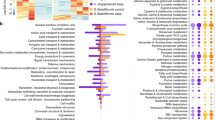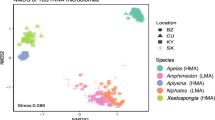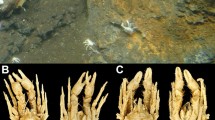Abstract
Sponges thrive in the deep, dark and nutrient-depleted ocean and may rely on microbial symbionts for carbon acquisition and energy generation. However, these symbiotic relationships remain largely unexplored. In this study, we analyze the microbiome of deep-sea sponges and show that ammonia-oxidizing archaea (AOA) of the family Nitrosopumilaceae make up at least 75% of the microbial communities of the sponges Aphrocallistes sp., Farrea sp. and Paratimea sp.. Given the known autotrophic metabolism of AOAs, this implies that these sponge holobionts can have the capacity for primary production in the deep-sea. We also show that specific AOA lineages are highly specific towards their hosts, hinting towards an unprecedent vertical transmission of these symbionts in deep-sea sponges. Our results show that the ecology and evolution of symbiotic relationships in deep-sea sponge is distinct from that of their shallow-water counterparts.
Similar content being viewed by others
Introduction
Symbiotic relationships with microorganisms are fundamental for sponges thriving in oligotrophic environments, such as the deep sea [1, 2]. In this environment, sponges could rely on chemolithoautotrophic microorganisms to obtain organic carbon [3]. Carbon fixation in such environments can be driven by the energy-efficient 3-hydroxypropionate/4-hydroxybutyrate (HP/HB) cycle, which has been found so far in all members of the ammonia-oxidizing archaea (AOA) belonging to the family Nitrosopumilaceae (phylum Thermoproteota, class Nitrososphaeria, order Nitrososphaerales) [4].
Substantial efforts have been recently made to analyze the microbial communities of deep-sea sponges [5, 6], although the importance of Nitrosopumilaceae has been overlooked. Here, we compare the relative abundances of amplicon sequencing variants (ASVs) assigned to this family across 107 different seawater, sediment and sponge samples collected from deep waters (~700 m) at the Campos Basin, Southeastern Brazil (22°38’S/40°25’W) (Supplementary Table S1). ROV-based sampling, individually contained transport to the surface and careful sample processing allowed us to generate sample-specific microbial community profiles (see Materials and Methods in Supplementary Text) to better define the fundamental associations between Nitrosopumilaceae, their hosts and the environment. Our results suggest that Nitrosopumilaceae are dominant in some deep-sea sponges and form highly species-specific relationship with their host
Results and discussion
ASV-based analysis for the V4 region of the 16S rRNA gene [7] of 72 samples from the sponge classes Hexactinellida (Farrea sp. and Aphrocallistes sp.) and Demospongiae (Paratimea sp., Calyx sp., Geodia sp., Pachastrella sp.) (Supplementary Figs. S1–6) showed distinct community profiles when considering sponge class or species (Supplementary Fig. 7) and a high relative abundance of sequences assigned to the family Nitrosopumilaceae (Fig. 1). Among the Hexactinellida, Nitrosopumilaceae ASVs represent, on average, 76.98 ± 0.04% of all reads in Farrea sp. and 97.70 ± 0.01% in Aphrocallistes sp., which was significantly higher than in sediments (average relative abundance 30.39 ± 14.18%, PERMANOVA F2 = 67.37, R2 = 0.63, p = 0.006) and seawater (average relative abundance 33.90 ± 11.56%, PERMANOVA F2 = 50.23, R2 = 0.61, p = 0.006). For Demospongiae, Nitrosopumilaceae ASVs constitute an average of 63.74 ± 5.10% of all reads in Paratimea sp., 53.15 ± 10.94% in Calyx sp., 42.54 ± 26.78% in Pachastrella sp. and 43.84 ± 13.97% in Geodia sp. The relative abundance of Nitrosopumilaceae ASVs within Paratimea sp. is significantly higher than in sediments (PERMANOVA F2 = 55.15, R2 = 0.52, p = 0.028).
More detailed analysis showed that the genus Nitrosopumilus dominates the samples from Demospongiae (up to 99.25% of all Nitrosopumilaceae reads), while the placeholder genus PXYB01 is more abundant in the Hexactinellida samples (up to 99.21% of all Nitrosopumilaceae reads) (Fig. 2, Supplementary Table 1).
The relative square-rooted abundances (heat-scale) of the 50 most abundant ASVs assigned to the Nitrosopumilaceae family are shown. Black squares in the heatmap refers to the ASV not being detected in the sample. The tree of the left is rooted with Nitrososphaera viennensis (not shown). Scale bar represents the tree scale. Rep. stands for replicate.
Our data also show that a single ASV (ASV2 – placeholder genus PBXY01) represents on average 98.17 ± 0.08% of the Nitrosopumilaceae reads across all 16 Aphrocallistes sp. samples (Fig. 2). To the best our knowledge, this is the first time that a single Nitrosopumilaceae ASV has been found to be present in such a high proportion in an environmental sample. A similar dominance is also observed for ASV1 (genus Nitrosopumilus) in Paratimea sp., which account for an average relative abundance of 91.31 ± 17.50%. Similarily, ASV6 constitutes, on average, 47.74 ± 2.43% of all Nitrosopumilaceae reads of Farrea sp. samples. This dominance of one ASV in the sponge samples contrasts the Nitrosopumilaceae community in seawater or sediments, where at least 7 and 5 ASVs, respectively, are needed to make up 50% of Nitrosopumilaceae reads. Finally, the ASVs found in high proportions in sponges are generally undetected or only found in low relative abundances in seawater and sediment samples supporting the notion of a high degree of specificity.
Functional redundancy of symbiotic microorganisms involved in nitrogen and carbon cycles has been noted for sponge holobionts [8]. However members of the family Nitrosopumilaceae seem to have an exclusive role in ammonium oxidation in sponges [9]. By oxidizing ammonium or urea, these microorganisms may contribute to detoxification processes in the sponge holobiont [10]. Furthermore, ammonium oxidation can generate the reductive power for carbon fixation and fixed organic carbon could ultimately be transferred to the sponge host, similar to what has been shown for cyanobacterial photosynthates in shallow-water sponges [11].
In contrast to recent studies [5], our results show that Nitrosopumilaceae symbionts have a species-specific relationship with their host, hinting to their possible vertical transmission. Vertical transmission is unlikely to be strong driver of community composition in variable environments and indeed is not very common in shallow-waters or near-shore sponges [12]. In contrast, the environmental stability of the deep sea [13] would allow, as shown here, for highly specific and possibly vertically transmitted symbioses to evolve. Our results also suggest the importance of chemolithoautotrophy through members of the Nitrosopumilaceae family in deep-sea sponges and further work will reveal how this contributes to the primary productivity of deep-sea communities.
Data availability
The raw reads have been deposited in the NCBI BioProject database (https://www.ncbi.nlm.nih.gov/bioproject/) under BioProject accession number PRJNA930637. All other study data are included in the article and/or supporting information files.
References
Li Z, Wang Y, Li J, Liu F, He L, He Y, et al. Metagenomic analysis of genes encoding nutrient cycling pathways in the microbiota of deep-sea and hallow-water sponges. Mar Biotechnol. 2016;18:659–71.
Webster NS, Thomas T. The sponge hologenome. mBio. 2016;7:e00135–16.
Li Z, editor. Symbiotic microbiomes of coral reefs sponges and corals. Springer Dordrecht; 2019, p. 81–104.
Hodgskiss LH, Melcher M, Kerou M, Chen W, Ponce-Toledo RI, Savvides SN, et al. Unexpected complexity of the ammonia monooxygenase in archaea. ISME J. 2023;17:588–99.
Steinert G, Busch K, Bayer K, Kodami S, Arbizu PM, Kelly M, et al. Compositional and quantitative insights into bacterial and archaeal communities of south pacific deep-sea sponges (Demospongiae and Hexactinellida). Front Microbiol. 2020;11:716.
Busch K, Slaby BM, Bach W, Boetius A, Clefsen I, Colaço A, et al. Biodiversity, environmental drivers, and sustainability of the global deep-sea sponge microbiome. Nat Commun. 2022;13:5160.
Thompson LR, Sanders JG, McDonald D, Amir A, Ladau J, Locey KJ, et al. A communal catalogue reveals Earth’s multiscale microbial diversity. Nature. 2017;551:457–63.
Fan L, Reynolds D, Liu M, Stark M, Kjelleberg S, Webster NS, et al. Functional equivalence and evolutionary convergence in complex communities of microbial sponge symbionts. Proc Natl Acad Sci USA 2012;109:E1878–1887.
Robbins SJ, Song W, Engelberts JP, Glasl B, Slaby BM, Boyd J, et al. A genomic view of the microbiome of coral reef demosponges. ISME J. 2021;15:1641–54.
Moitinho-Silva L, Díez-Vives C, Batani G, Esteves AIS, Jahn MT, Thomas T. Integrated metabolism in sponge-microbe symbiosis revealed by genome-centered metatranscriptomics. ISME J. 2017;11:1651–66.
Hudspith M, de Goeij JM, Streekstra M, Kornder NA, Bougoure J, Guagliardo P, et al. Harnessing solar power: photoautotrophy supplements the diet of a low-light dwelling sponge. ISME J. 2022;16:2076–86.
Björk JR, Díez-Vives C, Astudillo-García C, Archie EA, Montoya JM. Vertical transmission of sponge microbiota is inconsistent and unfaithful. Nat Ecol Evol. 2019;3:1172–83.
Yasuhara M, Danovaro R. Temperature impacts on deep-sea biodiversity. Biol Rev. 2016;91:275–87.
Acknowledgements
This paper was carried out in association with the ongoing R&D project registered as ANP 21005-4, “PROBIO-DEEP – Survey of potential impacts caused by oil and gas exploration on deep-sea marine holobionts and selection of potential bioindicators and bioremediation processes for these ecosystems” (UFRJ/Shell Brasil/ANP), sponsored by Shell Brasil under the ANP R&D levy as “Compromisso de Investimentos com Pesquisa e Desenvolvimento”. R.S.P. was also supported through KAUST grant number BAS/1/1095-01-01.
Funding
Open Access funding enabled and organized by CAUL and its Member Institutions.
Author information
Authors and Affiliations
Contributions
ANG and TT conceptualized and wrote the paper; ANG, BR, TD, FM, CM, CV, GD and LH collected samples; ANG and MEM contributed to analytical workflows, ANG and TT analyzed data; TT, RP, and GD conceptualized the expedition; ANG, BR, TD, FM, CM, CV and LH performed research.
Corresponding author
Ethics declarations
Competing interests
The authors declare no competing interests.
Additional information
Publisher’s note Springer Nature remains neutral with regard to jurisdictional claims in published maps and institutional affiliations.
Supplementary information
Rights and permissions
Open Access This article is licensed under a Creative Commons Attribution 4.0 International License, which permits use, sharing, adaptation, distribution and reproduction in any medium or format, as long as you give appropriate credit to the original author(s) and the source, provide a link to the Creative Commons license, and indicate if changes were made. The images or other third party material in this article are included in the article’s Creative Commons license, unless indicated otherwise in a credit line to the material. If material is not included in the article’s Creative Commons license and your intended use is not permitted by statutory regulation or exceeds the permitted use, you will need to obtain permission directly from the copyright holder. To view a copy of this license, visit http://creativecommons.org/licenses/by/4.0/.
About this article
Cite this article
Garritano, A.N., Majzoub, M.E., Ribeiro, B. et al. Species-specific relationships between deep sea sponges and their symbiotic Nitrosopumilaceae. ISME J 17, 1517–1519 (2023). https://doi.org/10.1038/s41396-023-01439-4
Received:
Revised:
Accepted:
Published:
Issue Date:
DOI: https://doi.org/10.1038/s41396-023-01439-4
This article is cited by
-
Diversity and potential host-interactions of viruses inhabiting deep-sea seamount sediments
Nature Communications (2024)





